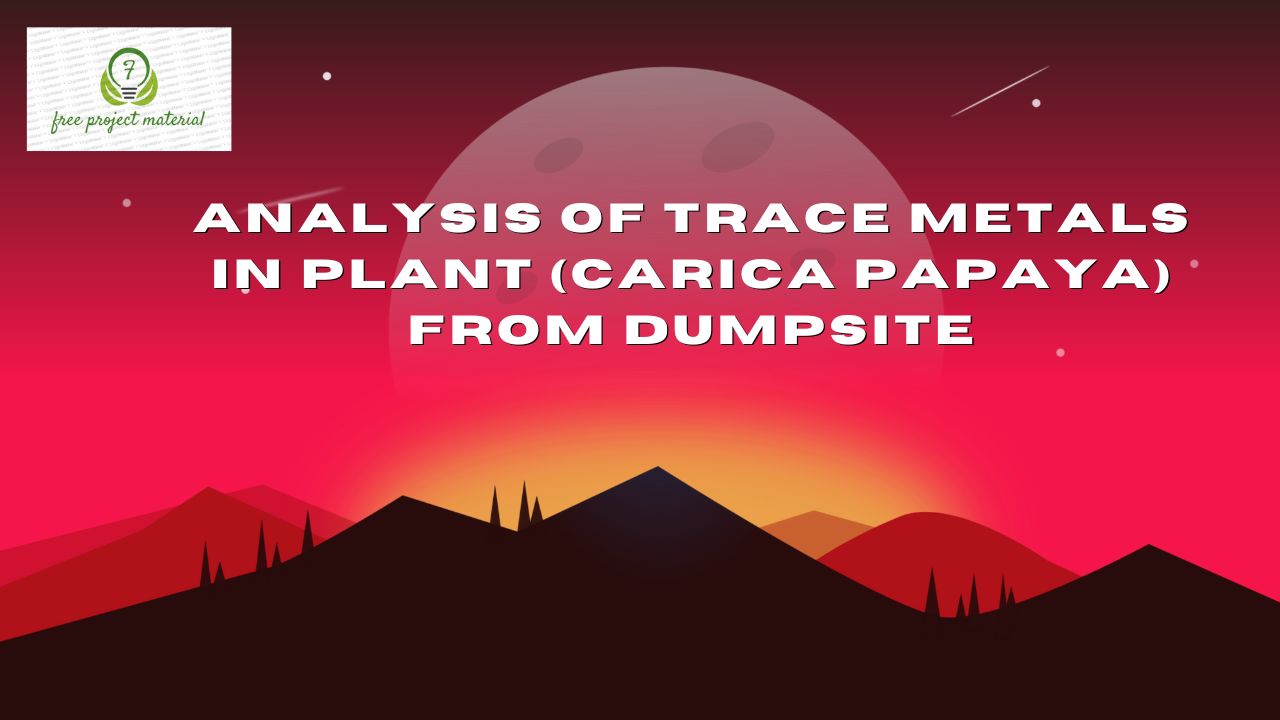ABSTRACT
The aim of this study was to determine the trace metal composition of Carica papaya leaves from a dumpsite at Idoro in Uyo L. G. A. Standard analytical method and flame atomic absorption spectrophotometer were used to analyze the samples. The result of the study revealed the following: Cd (0.662± 0.06mg/kg), Pb (0.256±0.02mg/kg), Ni (0.836±0.08mg/kg), Zn (0.118±0.011mg/kg), Fe (0.937±0.09mg/kg), Cu (0.468±0.046mg/kg), for Carica papaya from dumpsite while the control site had the following concentration; Cd (0.14±0.01 mg/kg), Pb (0.128±0.01 mg/kg), Ni (0.95±0.09 mg/kg), Zn (0.220±0.02 mg/kg), Fe (0.193±0.01 mg/kg) and Cu (0.105±0.01 mg/kg). Cadmium was higher than the WHO standard. This suggest possible risk to the consumers of the plant as such consumption of Carica papaya from the dumpsite should be avoided.
TABLE OF CONTENTS
Contents Page
Title page – – – – – – – – i
Certification – – – – – – – – ii
Dedication – – – – – – – – iii
Acknowledgements – – – – – – – iv
Abstracts – – – – – – – – – v
Table of Contents – – – – – – – – vi-vii
CHAPTER ONE: INTRODUCTION
1.1 Background of the Study – – – – – – 1-3
1.2 Aim and Objective of the Study – – – – – 3
1.2.1 Aim – – – – – – – – – 3
1.2.2 Objective – – – – – – – – 4
1.3 Scope and Limitation of the Study – – – – – 4
1.4 Definition of Related Terms – – – – – – 4
CHAPTER TWO: LITERATURE REVIEW – – – 5-11
2.1 Description of Carica papaya – – – – – 11-12
2.2 Medicinal Value of Carica papaya – – – – 13-14
2.3 Dumpsite – – – – – – – – 14-16
2.4 Trace Metal – – – – – – – – 16-17
2.5 Types of Trace Metal – – – – – – – 17-24
2.6 Sources of Metals in Soil – – – – – – 24-25
2.7 Remediation of Metals in Polluted Soil – – – – 25
2.7.1 Isolation – – – – – – – – 25-26
2.7.2 Immobilization – – – – – – – 26
2.7.3 Toxicity Reduction – – – – – – 26-28
2.7.4 Physical Separation – – – – – – 28
CHAPTER THREE: MATERIALS AND METHOD
3.1 Material – – – – – – – – 29
3.2 Collection of Sample – – – – – – – 30
3.3 Digestion of Sample – – – – – – – 30-31
3.4 Determination of Trace Metal – – – – – 31
CHAPTER FOUR: RESULT AND DISCUSSION
4.1 Result – – – – – – – – – 32-33
4.2 Discussion – – – – – – – – – 34-38
CHAPTER FIVE: CONCLUSION AND RECOMMENDATION
5.1 Conclusion – – – – – – – – – 39
5.2 Recommendation – – – – – – – 39-40
References
CHAPTER ONE: INTRODUCTION
1.1 Background of the Study
Carica papaya belongs to Caricaceae family and is commonly known as “papaya”. Papaya is a large tree-like plant with a single stem growing from 5 to 10m tall, with spirally arranged leaves confined to the top of the trunk. The lower trunk is conspicuously scared where leaves and fruit were born. The leaves are large, 50- 70 cm.
Papaya fruit is a berry that is spherically or cylindrical in form, covered with a smooth thin green skin, that turns yellow or red when ripen, with a succulent flesh (Chan and Teo, 2002). Papaya is used as anti-inflammatory, antioxidant diuretic, antibacterial, antifungal, vermifuge and immune modulatory agents (Noriko et al., 2010). The leaves of papaya is traditionally used for the treatment for malaria.
Heavy metals are naturally occurring elements that have a high atomic weight and a relatively high density compared to water (Fergusson, 1990).
Examples of heavy metals are Cobalt (Co), copper(Cu), Chromium (Cr), Iron (Fe), magnesium (Mg), Manganese (Mn), Molybdenum (Mo), Nickel (N), Zinc (Zn), Aluminum (Al), Arsenic (As) and Cadmium (Cd) etc.
Some of these metals have biological roles in plant, animal and micro-organisms such as; Potassium (K), Magnesium (Mg), Calcium (Ca), Copper (Cu), Iron (Fe), Zinc (Zn), Manganese (Mn) etc. Their biological roles includes: acting as cofactors for many enzymes, as well as acting centers for stabilizing structures of enzymes and proteins, participate in oxidation-reduction reaction in energy metabolism and also play a vital role in the transport of oxygen as a constituent of hemoglobin and myoglobin. Others even at low concentration, do not have any biological role.
Sources of heavy metals in the environment include: Industrial, agricultural, pharmaceutical and domestic effluents (Vasudevan and Sreekumari, 2007). In biological system, heavy metal can affect cellular organelles and components such as: cell membrane, mitochondrial, lysosome, endoplasmic recticulum, nuclei and some enzymes involved in metabolism, detoxification and damage repairs (Wang and Shi, 2001). Metal ions have been found to interact with cell components such as deoxyribonucleic acid (DNA) and nuclear protein, causing DNA damage and conformational changes that may lead to cell cycle modulation and carcinogenesis (Beyersmam and Hartwig, 2008).
Plant grown in polluted environment can accumulate heavy metals through their root at high concentration causing serious risk to human health when consumed. The consumption of heavy metals contaminated food can seriously deplete some essential nutrients in the body causing decrease in immunological defenses, impaired psycho-social behaviours, disabilities with malnutrition and a high prevalence of upper gastrointestinal cancer (Arora et al., 2008).
1.2 Aim and Objective
1.2.1 Aim
The aim of this research project is to determine the level of trace metals in Carica papaya leaves harvested from dumpsite and a control site at Idoro in Uyo Metropolis. This aim would be achieved through the following objectives
1.2.2 Objectives
- Determination of the level of trace metal in the leaf of Carica papaya from a control and a dumpsite
- Compare the result of this analysis with the International Standard (WHO, FAO and USEPA) and other studies conducted by other researchers.
- Make recommendation and suggestion for further studies based on the result obtained from this analysis.
1.3 Scope and Limitation
Due to time constraints and lack of adequate facilities, this research project is limited to trace metals level in Carica papaya leaves from a dumpsite and a control site in Uyo.
1.4 Definition of Terms
Heavy metals are defined as metallic element that has relatively high density compared to water.
Carica papaya:- it is a fruit commonly consumed, papaya is a related sources of vitamin A and C.
Dumpsite:- A pieces of land where waste materials are discarded.



